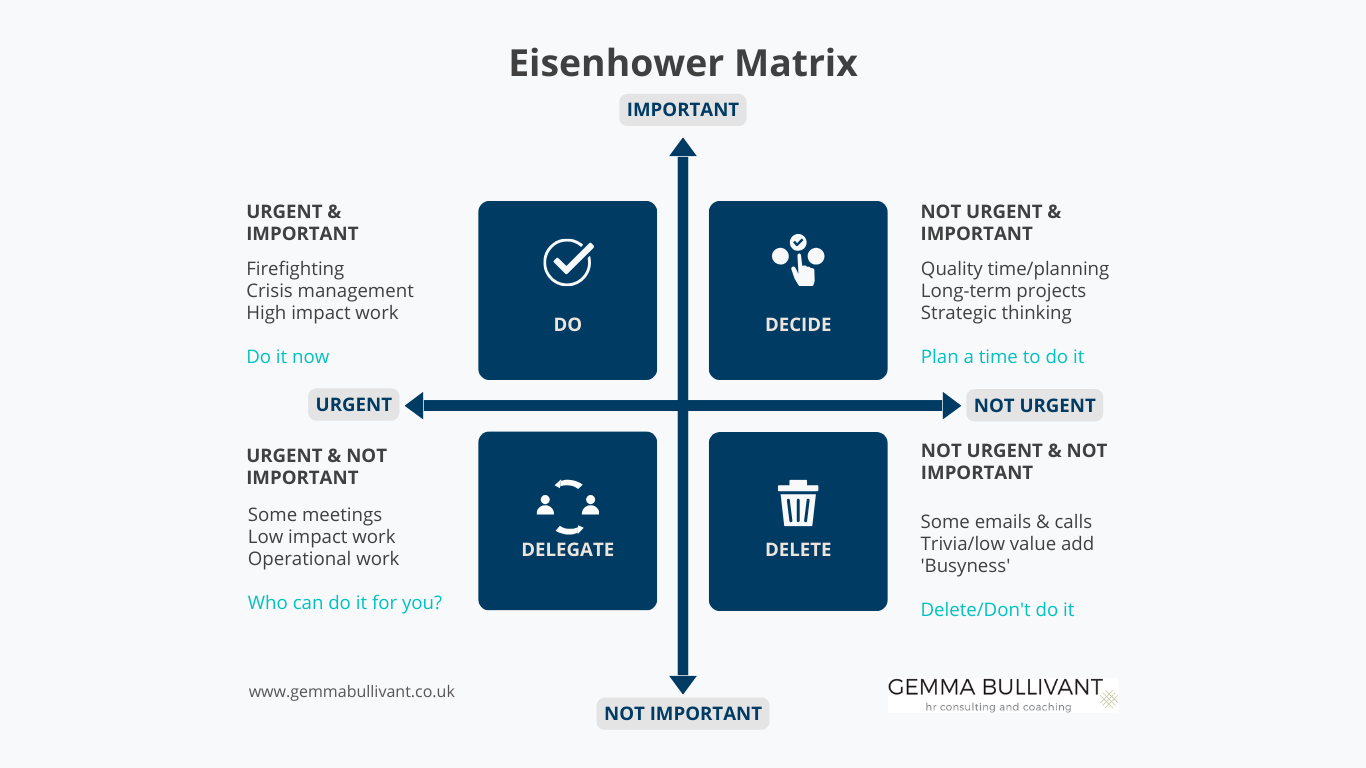Many HR leaders strive to be more productive and operate more strategically. If you are wondering how to use the Eisenhower Matrix, this article and podcast discuss this task management method, also known as the 4Ds: Do, Decide, Delegate, and Delete.
What is the Eisenhower matrix?
The Eisenhower Matrix is a simple and effective task management strategy named after President Dwight D. Eisenhower, who was known for helping individuals prioritise their tasks. For Eisenhower, the most important tasks had to go first, so he became the inspiration behind the Matrix, which helps you categorise tasks into four groups based on urgency and importance: Do, Decide, Delegate, and Delete.
The matrix categorises tasks into four quadrants:
- Urgent and Important: These are tasks that require immediate attention and are crucial to your long-term goals. They demand your focus and should be dealt with promptly.
- Important but Not Urgent: These tasks contribute to your long-term objectives but don’t require immediate action. They should be scheduled and given sufficient time for thorough completion to prevent them from becoming urgent later.
- Urgent but Not Important: These tasks may seem pressing but need to align with your long-term goals. Delegating or minimising time spent on these tasks is advisable to free up time for more crucial activities.
- Not Urgent and Not Important: These tasks are neither urgent nor essential to your goals. They are often distractions that should be minimised or eliminated altogether to focus on more meaningful activities.
By following these steps, you’ll be better equipped to manage your time effectively, prioritise tasks clearly, and ultimately boost your productivity. Give it a try and experience the difference the Eisenhower Matrix can make in your day-to-day life!
How can you use the Eisenhower matrix?
Do: Immediate Action
The ‘Do’ quadrant includes urgent and important tasks. These are high-impact or high-stakes tasks that require immediate attention. These tasks usually help you achieve important goals or move closer to your plans. For example, quickly answering a client’s question, handling a crisis, or completing urgent work for a key person.
Decide: Strategic Planning
Place tasks that are important but not urgent in the ‘Decide’ quadrant. These are high-impact or high-stakes tasks that need careful planning and decision-making before execution.
One example is planning your strategy for the next 6-12 months or longer. This involves identifying gaps and designing your organisation. It also includes creating a roadmap to reduce risks in the future.
Delegate: Who else can do this, or how else can this be done?
Urgent but less important tasks belong to the ‘Delegate’ category. This quadrant emphasises task delegation to capable team members, freeing your time for higher-impact responsibilities. If you don’t have a team to delegate to, consider how this task might be automated.
Delete: Clearing the Clutter – Do I really need to do this?
The ‘Delete’ quadrant is extremely powerful. It involves all those tasks that lack urgency and importance. Here, you want to focus on eliminating tasks that don’t help your goals or career growth. As soon as you determine a task is not worth doing, you delete it. This decluttering technique can help you feel in control and not overwhelmed by the amount of tasks pending
The Strategic Benefits of the Eisenhower Matrix:
The Eisenhower Matrix also serves as a compass for strategic thinking. Unlike most task management strategies, this method helps you discern where your efforts should truly lie.
It shifts you out of auto-pilot
When you look at your to-do list, you first ask yourself, ‘Do I actually need to be doing this?’ This question can help you shift out of autopilot (‘What shall I do first?’ Or ‘How will I get all this done?’) into a much more intentional mindset.
It’s easy to let busyness control you. You might think you just need to be more efficient, work harder, and stay late tonight.
It helps you prioritise ‘quality time’
You can use the matrix to identify how often you dedicate ‘quality time’ to yourself during your day. Taking breaks and making time for yourself in your schedule may seem like avoiding work. However, isn’t thinking ahead a crucial aspect of work?
Building relationships and planning are also important tasks that contribute to the success of your work. Therefore, taking breaks and making time for yourself can actually enhance your productivity in the long run.
It helps you navigate unexpected challenges
If you have to fight a fire, can you use it as a chance to bond with your manager? Can you also use it as an opportunity to improve safety measures? Turning a crisis into an opportunity is the ultimate benefit of a strategy. The model helps you avoid the “emergency trap” and provides clarity on how to allocate time and resources strategically, ensuring that tasks align with broader organisational goals, especially during an actual emergency.
Even the smallest shift in your mindset can help boost a more positive outlook on that otherwise unwelcome ‘pressing problem or crisis’.
Want to explore more task management strategies?
With over 20 years of experience in HR, I understand the challenges organisations face regarding task management and productivity. That’s why I’m here to offer my full expertise and support in optimising your workplace processes.
Whether you need help training and developing your team or implementing performance evaluation systems. I’ll work closely with you to understand your organisation’s unique needs and challenges. Together, we’ll develop customised task management solutions that align with your goals and objectives.
Schedule a call with me today so we can have a free, no-obligation chat about how I can help you reach your business goals.



